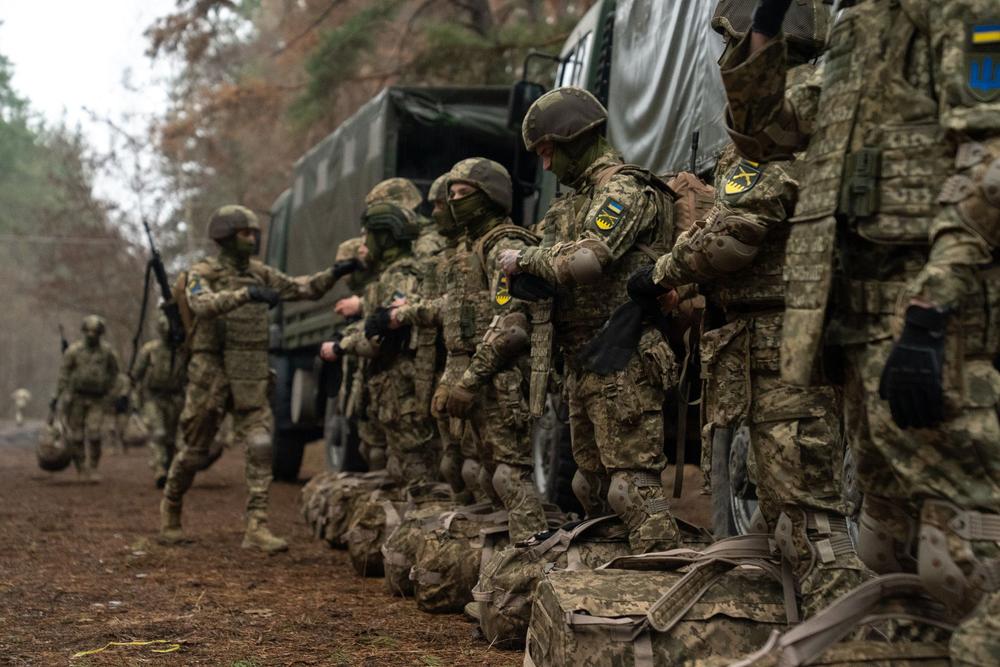Ukraine's move to a corps-based command structure aimed to boost military efficiency. Almost a year later, the promised improvements remain out of reach.
"It turned out to be an unfounded, hasty pseudo-solution," said Bohdan Krotevych, the former commander of Ukraine's Azov Brigade.
The Ukrainian army, which entered the full-scale war in 2022 with brigades as its largest standing units, has spent the past year restructuring into a corps-based system. Under this new structure, corps, typically comprising two to five brigades, or roughly 10,000 to 50,000 troops, serve as the highest operational units.
The reform also sought to phase out the use of operational-strategic groupings (OSUVs) — temporary command structures responsible for managing specific sectors of the front line by coordinating multiple operational-tactical groupings (OTUs) and tactical groupings (TGs).
However, many of the same challenges that plagued the old system persist, raising questions about the effectiveness and necessity of the overhaul.
According to Krotevych, the reform is largely theoretical, as none of the corps currently functions as a true operational unit, lacking full coordination and overseeing only one or two brigades — far fewer than required for effective operations.
"Corps commanders, who are usually more experienced than the heads of temporary military formations, were supposed to improve the situation," Krotevych told the Kyiv Independent.
"But the war has not waited, and by the time these decisions were implemented, the situation had deteriorated to a point where corps commanders could no longer influence it," he added.
The General Staff declined to comment for this story.
What has changed?
In the fall of 2024, the Ukrainian Armed Forces unveiled a concept for transitioning to a corps-based command system. This was followed by an official announcement on Feb. 3 from Commander-in-Chief Oleksandr Syrskyi, declaring the start of a major restructuring effort aimed at improving coordination and combat readiness across the army.
Temporary formations such as OTUs and OSUVs were introduced at the onset of Russia's 2014 invasion, functioning as intermediate operational levels within the military command structure. One of their main shortcomings was the lack of a clear chain of command and a defined hierarchy.
During large-scale combat operations, strategic leadership required a more coherent and permanent system. These limitations underscored the need for a comprehensive reorganization of the armed forces.
The resulting reforms aimed to resolve these issues by restructuring the army around corps formations, bringing greater clarity and cohesion to the command system.
Unlike temporary groupings, a corps is a permanent organizational unit, though its subordinate elements may rotate or change. Brigade commanders report directly to the corps commander, who is capable of operating independently.
Over the past year, the previously separate OSUVs, OTUs, and TGs have been consolidated into four regional commands — North, South, East, and West. According to publicly available information from the interim stage of the reform, these commands now encompass 18 corps.
When asked by the Kyiv Independent, the General Staff declined to comment on the number of corps, explaining that the information is classified as official use only.
Lieutenant General Andrii Hnatov, Ukraine's General Staff's chief, said in an interview with Ukrinform published on Oct. 1 that, for now, the reform is considered complete, acknowledging ongoing challenges related to staffing, training, and internal changes within the newly established structures.
Hnatov emphasized that the military is actively adopting approaches to increase the autonomy of tactical and operational-level commanders.
He added that leadership courses are underway, planning standards are being revised, and a new generation of commanders with direct combat experience is gradually being integrated into the command system.
A notable example of the reform's successful implementation was the deployment of the 1st Corps of the National Guard of Ukraine to the Dobropillia axis in Donetsk Oblast, where Russian forces had been attempting to infiltrate, according to Mykola Bielieskov, a senior analyst at the Come Back Alive initiative center.
The corps was able to coordinate all available and assigned units of Ukrainian forces, effectively stabilizing the situation on that front line, Bielieskov told the Kyiv Independent.
However, the effectiveness of the reform remains in doubt, as it is unfolding amid ongoing combat operations, and the brigades forming the basis of the new corps were already understaffed when the restructuring began.
"A corps is not just a grouping of five or six brigades — it must also be capable of supporting them and conducting full-scale combat operations," retired Ukrainian officer and defense expert Viktor Kevliuk told the Kyiv Independent.
According to Kevliuk, a fully functional corps should include a missile unit, an artillery brigade, an air defense brigade, and a range of combat support units — engineers, communications specialists, chemical defense troops, and a comprehensive logistics system. But the Ukrainian army's current capabilities are limited, he added.
"Where is all this supposed to come from when we do not even have enough infantry on the front lines?" Kevliuk said. "In my view, this reform is premature and does nothing to improve the situation."
One of the main obstacles to implementing the reform is the ongoing active hostilities, several experts told the Kyiv Independent. These conditions prevent the full regrouping of brigades within their designated corps. As a result, some corps are forced to operate with brigades that do not formally belong to them.
"Сorps are generally forced simply to command the brigades around them, which in many cases are not the ones assigned to the corps, since brigades cannot easily be redeployed to join their corps," John Hardie, deputy director of the Russia Program at the Washington-based Foundation for Defense of Democracies, said.
The Tavriia, North, and Odesa OSUVs had been disbanded earlier, but one of the most recent changes was the dissolution of the Dnipro OSUV, led by Mykhailo Drapatyi, a move confirmed by the General Staff on Oct. 6.
Forty-two-year-old Drapatyi is one of Ukraine's most experienced military officers. He has been involved in the war with Russia since 2014, rising through the ranks from a regular soldier to a senior position within the General Staff.
During the full-scale invasion, he played a key role in liberating Kherson Oblast, commanded Kharkiv and Luhansk OTUs, and led the reform of the Ground Forces.
While the official explanation linked the decision to ongoing military reform, an undisclosed military source told Ukrainska Pravda that it was allegedly driven by internal power dynamics and intended to remove a potential rival to Syrskyi — Drapatyi.
In mid-September, Syrskyi also dismissed the commanders of the 17th and 20th corps for allegedly losing positions within their areas of responsibility, Ukrainska Pravda reported, citing military sources.
At the time, the 17th Corps was stationed in Zaporizhzhia Oblast, where Ukrainian forces lost control of the village of Kamianske and part of Plavni, located along the banks of the Dnipro River. The 20th Corps was positioned along the border of Donetsk and Dnipropetrovsk oblasts, where Russian forces had first breached the line in August.
Reacting to the developments, the experts who spoke with the Kyiv Independent highlighted a pattern of excessive micromanagement by the General Staff and Syrskyi personally, which they said is undermining the effectiveness of the Ukrainian army.
"Who is going to manage the corps now — the commander in chief himself?" Kevliuk said. "The number of command layers is not decreasing, but the quality of leadership is not improving either."
The Kyiv Independent reached out to Hnatov to discuss the effectiveness of the reform at its current stage. Yet the General Staff denied the request for a comment, with officials citing that the questions pertained to classified information.
Are there alternatives?
The interim completion of the corps system reform comes at a particularly sensitive moment on the battlefield.
Over the summer, Russian forces advanced toward the city of Kupiansk in Kharkiv Oblast, entered Dnipropetrovsk Oblast, and continued to push forward in Donetsk Oblast, especially near the cities of Pokrovsk and Dobropillia.
Amid these deteriorating conditions, the newly formed corps structures have been unable to fully coordinate or operate at peak effectiveness in combat, the experts told the Kyiv Independent.
"Some (commanders) do not even know each other, yet they are expected to sit together, plan in real time, provide mutual support, and respond to a rapidly changing operational picture," Kevliuk said, adding that Russia's overwhelming manpower, usually used as an expendable force, further complicates Ukraine's efforts.
Still, according to Kevliuk, Ukraine's comparative advantage lies in battlefield adaptability, technological integration, and the ability to leverage educated personnel capable of managing these tools effectively.
"The key is not the sign on the command post door," Kevliuk said. "What will make a real difference is a shift to asymmetric and non-traditional force structures, a creative adaptation of the old NATO air assault doctrine. That offers a far greater chance of success than simply reshaping the command system."
Former Azov Brigade commander Krotevych, in turn, has long advocated for a shift toward the formation of divisions.
A division is a key tactical unit in the military, typically comprising 6,000 to 25,000 troops and made up of several regiments or brigades. Depending on the branch, it can operate independently or as part of a larger corps or army.
According to Krotevych, a gradual transition to this structure would allow depleted brigades to be consolidated into smaller combat-ready units, enabling better coordination and more efficient replenishment.
Krotevych also argued that such reorganization is more feasible at the divisional level, unlike corps-level formations, for which the Ukrainian Armed Forces lack sufficient reserves.
Military analyst Bielieskov explained that what Ukraine refers to as a "corps" is effectively equivalent to a divisional system in most NATO countries — a large formation typically consisting of up to four brigades, along with dedicated artillery, engineering, and air defense units.
According to him, the term "corps" prevailed in public discourse, which is why it was ultimately adopted.
"Ideally, it would have been better to build from smaller to larger formations, rather than skipping the divisional level," he said. "But as it stands, division headquarters are significantly smaller in terms of personnel than corps headquarters."
The analyst added that while corps headquarters can be established, the supporting units — such as engineering, artillery, and air defense — often lack the necessary personnel and still require significant replenishment.
"Assembling a group of forces and calling it a corps does not make it one in terms of operational art," Bielieskov said.
He emphasized that true operational capability depends on synchronization and scale — factors that rely on trained officers at the operational-tactical level. "These are matters of experience and skill that can only be developed through practice," Bielieskov added.
Yet structural changes alone are not enough — what is needed is a fundamental shift in leadership culture.
"One person cannot change this system," former commander Krotevych said. "It requires a team of professional military personnel who are both patriotic and skilled enough to take on the task of fixing the breakdowns at the front line."
"We need a commander-in-chief who knows how to work with difficult — but capable — commanders. Not everyone you like is skilled — and conversely, those who do not like you and have their own opinions can be extremely effective," he added.

 Taylor Swift Announces 6-Episode Eras Tour Disney+ Documentary and Concert Film of Final Show
Taylor Swift Announces 6-Episode Eras Tour Disney+ Documentary and Concert Film of Final Show